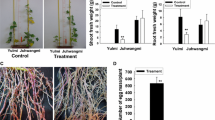Abstract
Nematophagous fungi such as Trichoderma viride show promising potential in the biological control of plant-parasitic nematodes. Furthermore, Meloidogyne spp., root-knot nematodes, has a great impact on the economy. The current study aimed to evaluate the parasitism ability of this fungus and to predict possible mechanisms involved in controlling the root-knot nematode, Meloidogyne javanica. In vitro bio-assays of direct parasitism, SEM observation, pot experiment testing the effect of soil treatment by T. viride, and isobaric tag for relative and absolute quantitation (iTRAQ) methodology were employed to characterize the biological and molecular features of this fungus. The high nematicidal activity was observed with the presence of Trichoderma species. The SEM observation of nematode parasitized juvenile suggests the production of lytic enzymes degrading the cell wall and penetrating fungal hyphae into M. javanica juveniles. The soil treatment by T. viride showed a significant boost of the tomato plant growth, a decrease of the root-knot nematode development in terms of galls number, gall index and multiplication rate and induction of defense responses by activating several ROS enzymes. A total of 1344 unique proteins were identified from the T. viride mycelium. These proteins were mainly related to signaling stress response, bio-energy, metabolism and protein synthesis and degradation. Our results provide a comprehensive dataset of several proteins involved in the biocontrol mechanisms of T. viride. The combination of several mechanisms allowed this filamentous fungus to be a successful candidate in controlling sustainably the root-knot nematodes, in particular, in Mediterranean ecosystems.
Access this chapter
Tax calculation will be finalised at checkout
Purchases are for personal use only
Similar content being viewed by others
References
Alabouvette, C., Olivain, C., Migheli, Q., Steinberg, C.: Microbiological control of soil-borne phytopathogenic fungi with special emphasis on wilt-inducing Fusarium oxysporum. New Phytol. 184, 529–544 (2009)
Brunner, K., Zeilinger, S., Ciliento, R., Woo, S.L., Lorito, M., Kubicek, C.P., Mach, R.L.: Genetic improvement of a fungal biocontrol agent to enhance both antagonism and induction of plant systemic disease resistance. Appl. Environ. Microbiol. 71, 3959–3965 (2005)
Dutta, P., Karmakar, A., Majumdar, S., et al.: Klebsiella pneumoniae (HR1) assisted alleviation of Cd(II) toxicity in Vigna mungo: a case study of biosorption of heavy metal by an endophytic bacterium coupled with plant growth promotion. Euro-Mediterr. J. Environ Integr. 3, 27 (2018)
Harman, G.E., Howell, C.R., Viterbo, A.: Trichoderma species opportunistic, avirulent plant symbionts. Nat. Rev. Microbiol. 2, 43–56 (2004)
Karel, B.: A Review of World Bank Projects and Their Compliance with the World Bank’s Pest Management Policy, 1999–2003. PANNA, San Francisco (2004)
Monteiro, V.N., do Nascimento Silva, R., Steindorff A.S., Costa, F.T., Noronha, E.F., Ricart, C.A., de Sousa, M.V., Vainstein, M.H., Ulhoa, C.J.: New insights in Trichoderma harzianum antagonism of fungal plant pathogens by secreted protein analysis. Curr. Microbiol. 61, 298–305 (2010)
Mostafalou, S., Abdollahi, M.: Pesticides and human chronic diseases: evidences, mechanisms and perspective. Toxicol. Appl. Pharmacol. 268(2), 157–177 (2013)
Parnell, S., van den Bosc, F., Gilligan, C.A.: Large-scale fungicide spray heterogeneity and the regional spread of resistant pathogen strains. Phytopathology 96, 549–555 (2006)
Rodrigues, C., Cunha, M.Â.: Assessment of the microbiological quality of recreational waters: indicators and methods. Euro-Mediterr. J. Environ. Integr. 2, 25 (2017)
Schuster, A., Schmoll, M.: Biology and biotechnology of Trichoderma. Appl. Microbiol. Biotechnol. 87, 787–799 (2010)
Singh, V., Upadhyay, R.S., Sarma, B.K., Singh, H.B.: Seed biopriming with Trichoderma asperellum effectively modulate plant growth promotion in pea. Int. J. Agric. Environ. Biotechnol. 9(3), 361–365 (2016)
Karnovsky, M.J.: A formaldehyde-glutaraldehyde fixative of high osmolality for use in electron microscopy. J. Cell Bio. 27, 137A (1965)
Ciordia, S., Robertson, L., Arcos, S.C., González, M.R., Mena, M.d.C., Zamora, P., Vieira, P., Abrantes, I., Mota, M., Castagnone‐Sereno, P. and Navas, A.: Protein markers of Bursaphelenchus xylophilus Steiner & Buhrer, 1934 (Nickle, 1970) populations using quantitative proteomics and character compatibility. Proteomics 16(6), 907–1046 (2016)
Author information
Authors and Affiliations
Corresponding author
Editor information
Editors and Affiliations
Rights and permissions
Copyright information
© 2021 The Editor(s) (if applicable) and The Author(s), under exclusive license to Springer Nature Switzerland AG
About this paper
Cite this paper
Hajji-Hedfi, L. et al. (2021). Insights into Nematode Biocontrol Potential Through Biological and Proteomics Analysis of the Fungus Trichoderma viride. In: Ksibi, M., et al. Recent Advances in Environmental Science from the Euro-Mediterranean and Surrounding Regions (2nd Edition). EMCEI 2019. Environmental Science and Engineering(). Springer, Cham. https://doi.org/10.1007/978-3-030-51210-1_210
Download citation
DOI: https://doi.org/10.1007/978-3-030-51210-1_210
Published:
Publisher Name: Springer, Cham
Print ISBN: 978-3-030-51209-5
Online ISBN: 978-3-030-51210-1
eBook Packages: Earth and Environmental ScienceEarth and Environmental Science (R0)




